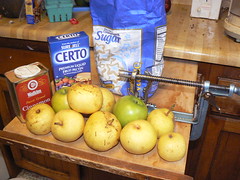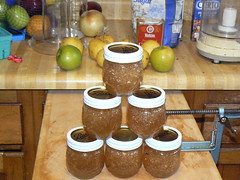So once again I face a pile of Asian pears that I cannot trust. They look fine on the outside, but I know that about half will have a brown, disgusting surprise in the center. Everyone in my family has learned to cut the pears in quarters before eating them. But there are too many to eat fresh, and I don't want to give them to people I like (or have to face again) for fear of what will happen after they chomp into one first thing in the morning and spend the rest of the day blowing chunks. What to do?
In the last few years I've found good uses for this slightly-substandard bounty. I make jam and pear butter. Lots of jam and pear butter. Then I have Christmas gifts for my co-workers, as well as the friend who pops by at holiday time with no notice, bearing a gift. My family's favorite is pear-apple jam, which captures the sweet scent of ripe fruit and cinnamon (along with the sweet taste of an obscene amount of sugar). I've seen this recipe in several places, including the Michigan State University Extension site. If you peel, core, and chop the fruit by hand, it's a lot of work. I'm lazy, so I use a peeler/corer/slicer gadget designed for apples (which works great on Asian pears since they're the same shape) and a food processor to do the chopping. That makes the task pretty easy, even for a novice jam-maker like me. Here's what you need:

And here's what you get:

Yum!


